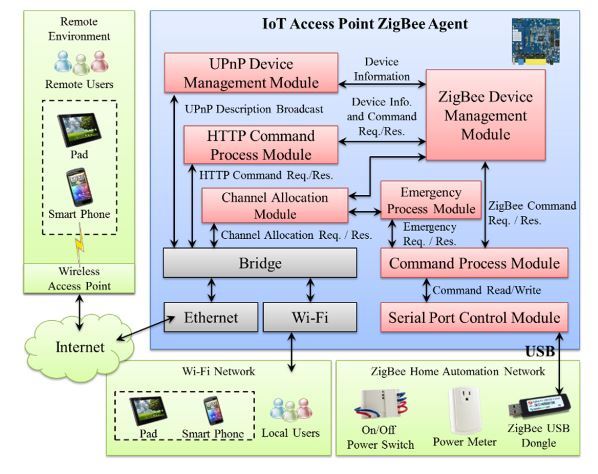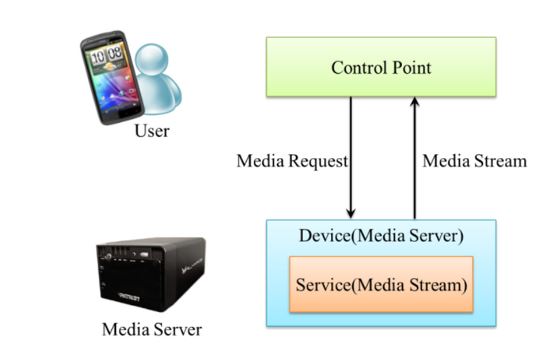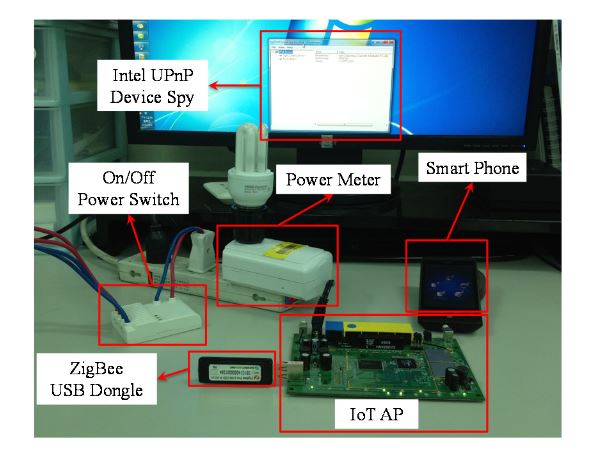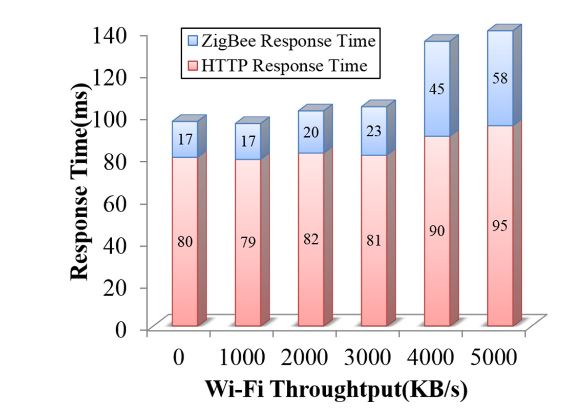ABSTRACT
Network communication and micro-electro-mechanical embedded technologies have attracted much attention in recent years. Through these technologies, the capabilities of sensing, identification, and communication can be embedded in various smart devices. These smart devices can automatically connect to the Internet and form an intelligent network called Internet of Things (IoT). However, these devices are em bedded with different wireless communication interfaces such as Wi-Fi and ZigBee.
This paper presents the design and implementation of an IoT access point that supports functionalities of coordination of various wireless transmission protocols. Based on the existing Wi-Fi access point, we have embedded a ZigBee module and implemented ZigBee and UPnP protocols into the designed IoT access point, which supports ZigBee communication capabilities over the Internet.
RELATED WORKS
The IoT supports various applications. Smart Life is one of the IoT supported applications that aims to make human beings lives more convenient. In literature, a large amount of papers had proposed the design and implementation of the IoT gateway. However, there are several differences between commercial IoT gateways and the developed IoT AP. The following presents the major differences. In past literature, the communication technologies applied to home automation can be classified into three categories: the wired home automation system, the wireless home automation system, and the integrated home automation system.
SYSTEM ARCHITECTURE OF THE IOT AP

Figure 2. The system architecture of the proposed IoT AP
The proposed IoT AP is integrated with the applied technologies in IoT smart home applications. As shown in Figure 2, the IoT AP provides three types of communications within the heterogeneous network, such as ZigBee, Wi-Fi, and Ethernet. Through this IoT AP, a home network can be established to control home devices by using the low-power ZigBee protocol. Afterward, through the ZigBee agent embedded in the IoT AP, the remote and local users are able to obtain the access right of controlling the ZigBee-based home devices.
SYSTEM ARCHITECTURE OF THE IOT AP

Figure 3. The ZigBee Agent system architecture
The ZigBee agent plays the role of an intermediary device between a USB transceiver and a ZigBee device. The ZigBee agent connecting to the ZigBee device provides the ZigBee control service for users through the Internet. In this paper, we develop the ZigBee agent based on the embedded Linux by installing RT3052 development board. Figure 3 depicts the system architecture of the developed ZigBee agent consisting of ZigBee modules, including the Serial Port Control Module, the Command Process Module, the ZigBee Device Management Module, the UPnP Device Management Module, the HTTP Command Process Module, the Channel Allocation Module, and Emergency Process Module. The details of module functionalities are elaborated in the next paragraph.

Figure 5. UPnP basic components diagram
Figure 5 depicts that a user controls UPnP devices through a smartphone. Initially, the UPnP software application is in stalled in the smartphone, namely the UPnP CP. It is responsible for searching and controlling the UPnP devices. In this situation, the UPnP device plays the role of a media server that provides streaming to execute the command for processing the CP. After a smartphone has discovered a multimedia server, it requests a media streaming. The realization of UPnP streaming is divided in to five main steps, including Discovery, Description, Control, Event Notification, and Presentation. In the Discovery step, the smartphone allows the control point to broadcast its service through SSDP protocol.
BUILDING SMART HOME BY USING IOT AP

Figure 7. Smart Home system established by the IoT AP
As shown in Figure 7, this section explains the development of the proposed IoT AP to build a smart home application. This paper proposes the configuration of two ZigBee devices, which are the power meter and on/off power switch. These devices are sold by simple home net company and have been certified by the ZigBee Alliance. In Section 5.1 the description of ZigBee devices configuration for home automation system is presented. Section 5.2 describes the configuration of the wireless Internet protocols channel for ZigBee and Wi-Fi. Section 5.3 describes the utilization of UPnP and HTTP to verify the correctness of the ZigBee agent operation.

Figure 10. Using Device Spy to find UPnP devices
In addition, there are multimedia Controller, Renderer, and Server which can allow the UPnP multimedia applications to be operated directly on a Windows computer. This paper uses the desktop computer, notebook computer, and smart mobile phone connecting to the designed IoT AP through Wi-Fi and uses Device Spy to confirm whether or not the IoT AP broadcasts the ZigBee devices through the UPnP. As shown in Figure 10, two UPnP devices can be found by using the Device Spy. The device information can be obtained by clicking one of the devices.
IOT AP PERFORMANCE EVALUATION

Figure 12. The impact of ZigBee/Wi-Fi band va riation on the ZigBee response time
Figure 12 depicts the band variation between various Wi-Fi throughputs (0 KBps, 2000 KBps, and 4000 KBps) and ZigBee response time. The Wi-Fi channel is fixed to CH1 (2.412 GHz) and the ZigBee channel used for testing is changed. The horizontal axis represents the band variation between ZigBee and Wi-Fi (0.002–0.068 GHz) whereas the vertical axis represents the ZigBee response time. As shown in Figure 12, when the Wi-Fi throughputs are 0 KBps and 2000 KBps, th e band variation between ZigBee and Wi-Fi has minimal impact against the ZigBee response time, which is 21 ms. When the Wi-Fi throughput is 4000 KBps, the bands used by ZigBee are closer to the Wi-Fi band, which results in longer response time.

Figure 15. The impact of Wi-Fi throughput variation on the command execution response time
Figure 15 shows the response time of command execution which is sent from a handheld device to the IoT AP through the Wi-Fi network with a variation of Wi-Fi throughputs. The Wi-Fi channel is set to CH 1, whereas the ZigBee channel is set to CH 12. In Figure 15, the Wi-Fi throughput is varied from 0 to 5000 (KB/s). The horizontal axis represents the variation of Wi-Fi throughputs, whereas the vertical axis represents the sum of HTTP response time and ZigBee response time. As shown in Figure 15, when the Wi-Fi throughput ranges between 0 KBps and 3000 KBps, the total Wi-Fi response time has minimal impact. When the Wi-Fi throughput exceeds 3000 KBps, the HTTP response time and ZigBee response time are affected by background interference, which results in longer response time.
CONCLUSIONS
This paper proposes the integration of ZigBee communication, Wi-Fi communication, and Internet connection capabilities onto a traditional Wi-Fi AP by combining the AP with ZigBee standard. With the proposed approach, the original Wi-Fi AP can be upgraded to an IoT AP. The novelty and contribution of the proposed IoT AP is summarized below. (1) IoT AP adaptively provides negotiation of channel usages between Wi-Fi network and ZigBee networks and help ZigBee network to allocate channel in a shorter response time; (2) Wi-Fi interference can compete with other Wi-Fi devices and reserve the allocated bandwidth res ource for ZigBee network.
This function fully resolves the existing problem of unbalanced resource competition between Wi-Fi and ZigBee interferences; (3) IoT AP supports dual modes of ZigBee operations, including power saving mode and emergency mode. By reducing the frame size, the IoT AP provides ZigBee devices with more opportunities to transmit data in a short cycle; and (4) the data collected from IoT devices can be forwarded directly to the data server or data center via the Internet in a more efficient way, as compared with the existing solutions. This helps the IoT AP can save more energy consumptions and reduce the response time. Performance results show that the proposed IoT AP not only prevents the ZigBee network contention and collision, but also saves energy consumption, as compared with the existing solutions.
Source: Tamkang University
Authors: Chih-Yung Chang | Chin-Hwa Kuo | Jian-Cheng Chen | Tzu-Chia Wang
>> 200+ IoT Led Projects for Final Year Students
>> IoT Software Projects for Engineering Students
>> More Wireless Embedded Projects for Engineering Students
>> More Wireless Energy Projects for Engineering Students